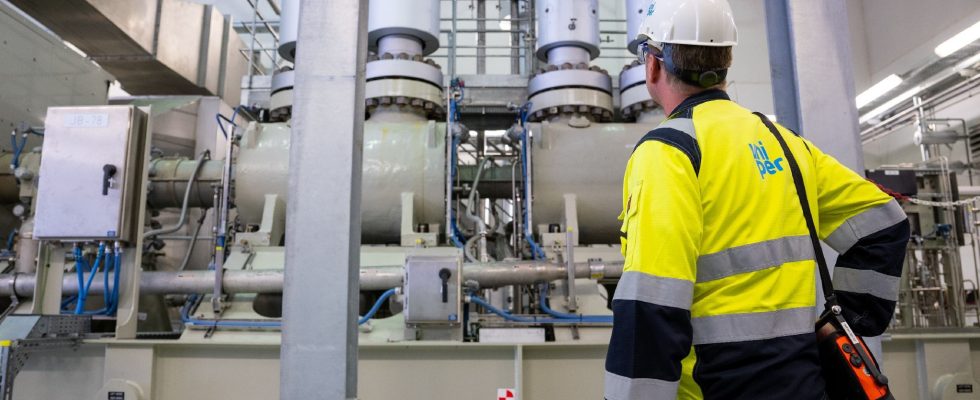In mid-August, Brussels prided itself on having achieved its objective two and a half months in advance: to have EU gas reserves filled to more than 90% – a deadline it had set for November 1. A sign that the continent is “well prepared” for next winter, the European Commission announced on August 18. The EU is still determined to break its energy dependence on Russia, whose gas imports only represented 15% in the 1st quarter of 2023 (compared to 50% in 2019).
To increase their gas reserves, the EU countries, meeting within the Council, adopted a regulation in June 2022 aimed at filling their storage capacities as much as possible before the cold season. The goal is that they can be redistributed in the Union once the winter season has come, in a spirit of solidarity. Also, the Member States had undertaken to reduce their gas consumption by 15% over the period from April 2023 to the end of March 2024 compared to the average recorded over the years 2017-2022. Last year, this target was largely exceeded thanks to mild weather and high prices which prompted households and businesses to save money.
According to aggregate data from “Gas Infrastructure Europe“(GIE), an association bringing together European gas infrastructure operators, European reserves contained a total of 93 billion cubic meters in August. With disparities depending on the State: in France, the level of storage rose to 87.24% as of August 25. It is 100% in Spain, but “only” 79% in Latvia. In neighboring Germany, the gauge reached 93%; 97% in Portugal; 89 % in Belgium.
Germany, France… Significant storage capacities
Les Vingt-Sept has a total gas storage capacity of 1,140 terawatt hours (TWh), which is mainly in reservoirs, depleted deposits or underground aquifers. The countries with the largest storage capacities are Germany, France, Italy, the Netherlands and Austria. These five states “represent up to two thirds of the total capacity of the EU”, underlines the site of the European Council. Because other members, at the same time, do not have gas storage facilities: Cyprus, Estonia, Finland… They must therefore conclude solidarity agreements with other Member States in order to secure their reserves.
Other good news: demand for gas in Europe fell sharply in the first half of 2023. And this trend seems set to continue until the end of the year, estimates the Gas Exporters Forum (GECF), in a monthly report published in August. In the second half of the year, “the probability of observing similar trends in natural gas consumption in Europe remains particularly high”, indicates the GECF, which brings together a dozen gas exporting countries, excluding the United States. It is based in particular on the most recent weather forecasts “which suggest that the fourth quarter of 2023 will be characterized by relatively warmer conditions”.
In addition, gas prices for this winter should be around 50 euros per megawatt hour, according to the Dutch benchmark Title Transfer Facility (TTF). Far from the levels during the crisis, when the amounts reached three times. However, the gas market remains vulnerable to sudden outbreaks of fever. Less Russian gas also exposes the EU to greater price fluctuations in the global liquefied natural gas (LNG) market.
In early August, prices soared after strike threats at major Australian gas facilities, and against a backdrop of robust Asian demand. There was nothing surprising about this increase, however, since it responded to greater demand, with European countries being in the middle of the season to fill up their stocks in order to approach winter serenely. In mid-August, the price of gas fluctuated around €38 per MWh.
So should we worry about the coming winter? Although European countries have restocked their stocks, this is still insufficient. Gas storage facilities in Europe, as full as they are, meet just under a third of European needs. In 2022, gas consumption was nearly 4,000 TWh. And the needs vary according to the country: Latvia has a capacity that covers 185% of its consumption, and therefore allows it to export to its Lithuanian and Estonian neighbours. On the contrary, Belgium can only store 4.4% of its needs.
For France, which recently authorized two coal-fired power stations to operate until the end of 2024 to avoid any winter blackouts, the gas reserve, at its maximum level, is equivalent to 28.5% of annual needs. France alone produces 136.35 TWh of underground natural gas storage capacity, i.e. less than a third of its annual gas consumption, which stands at around 450 TWh, according to the Energy Regulation Commission . As part of Europe, France will be forced to rely on imports by gas pipeline or LNG tankers. And for good reason: LNG represents approximately two-thirds of France’s gas supplies.
